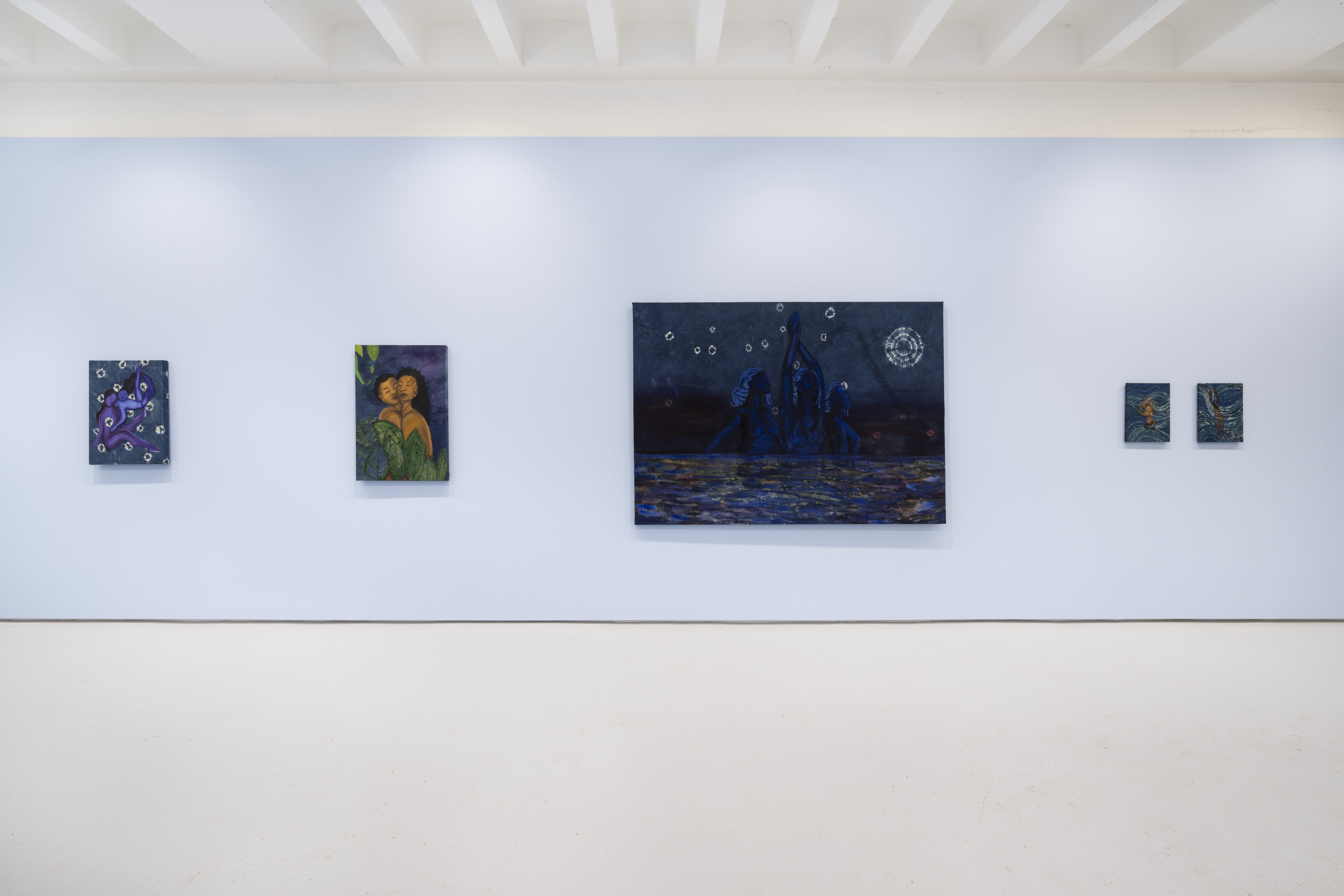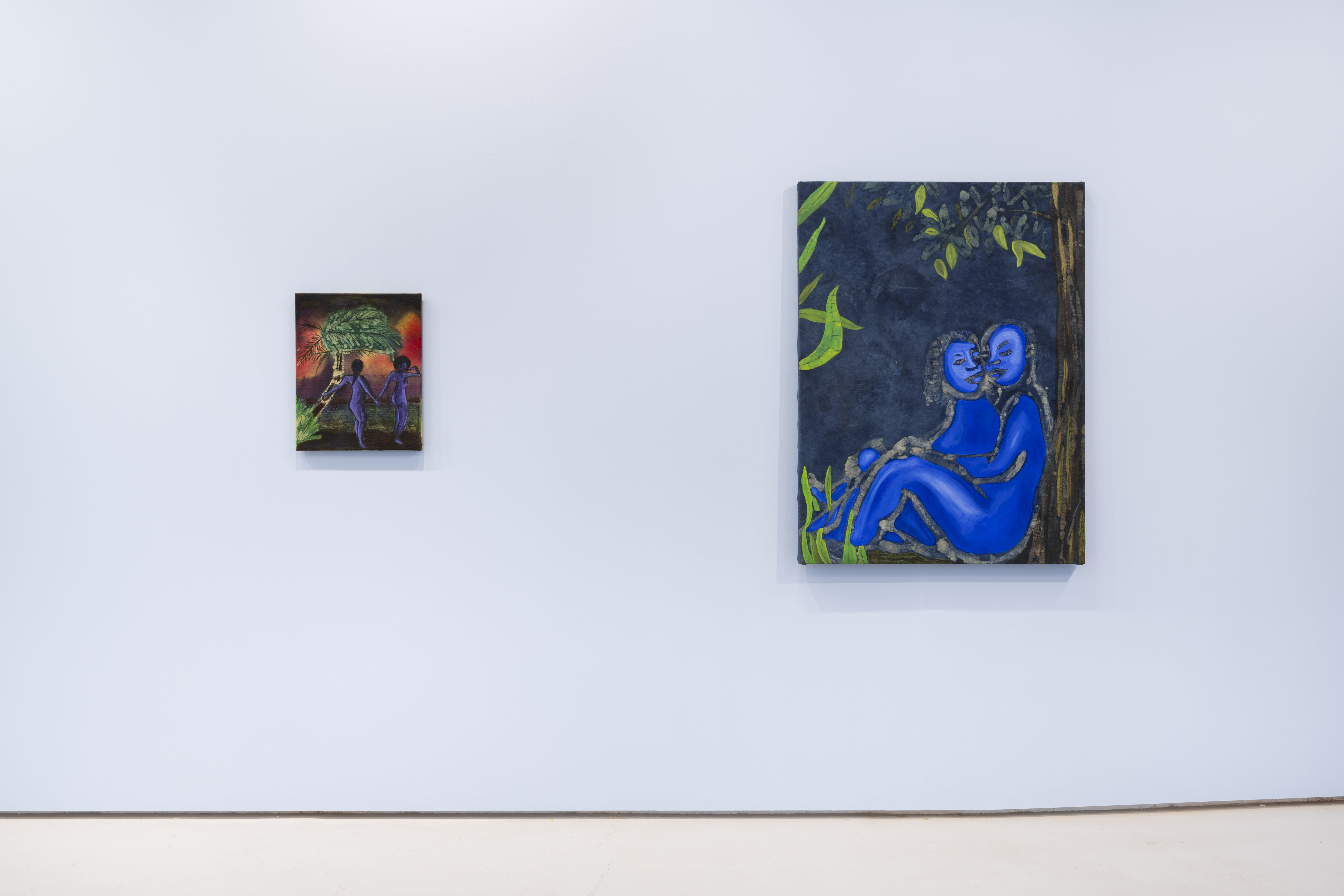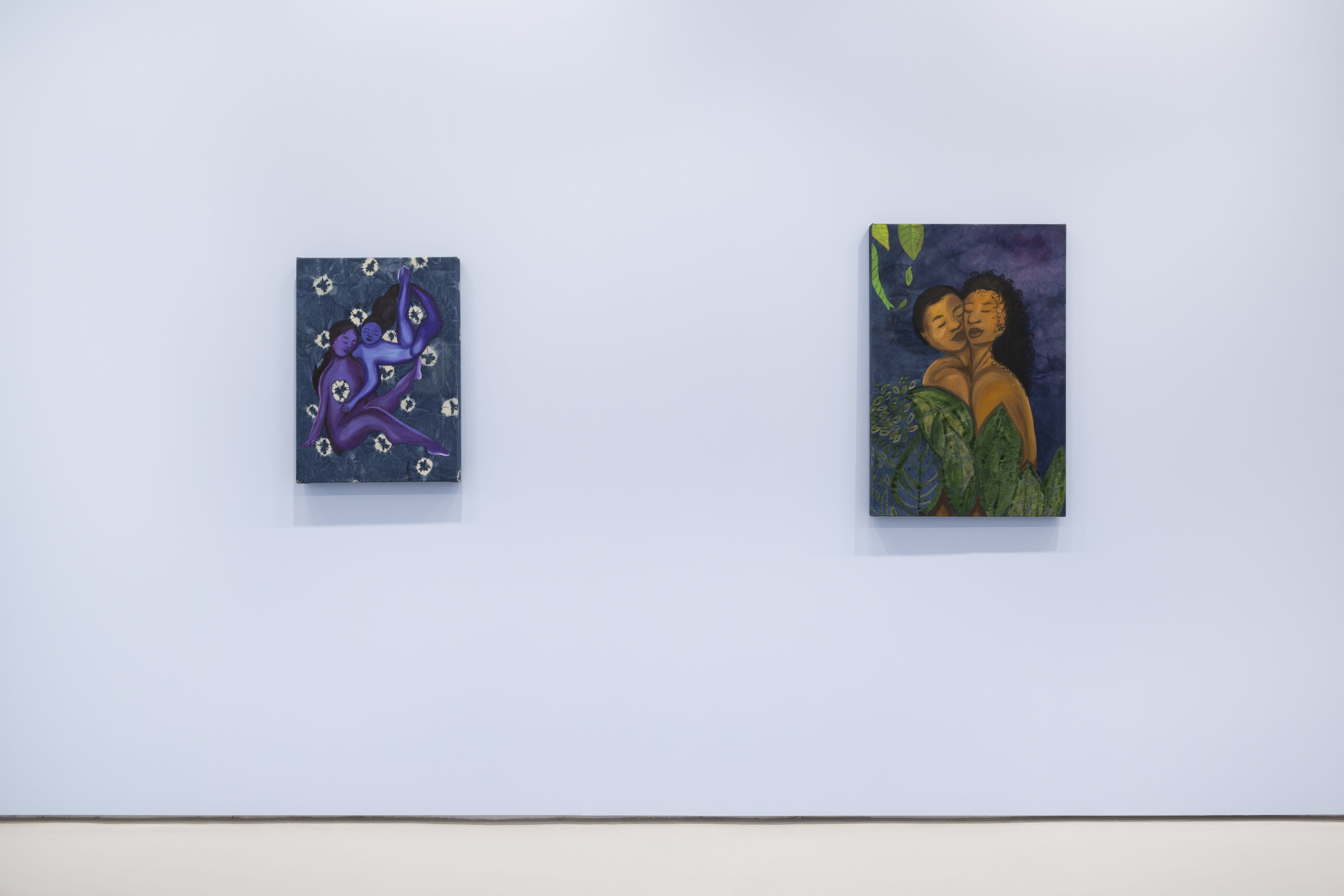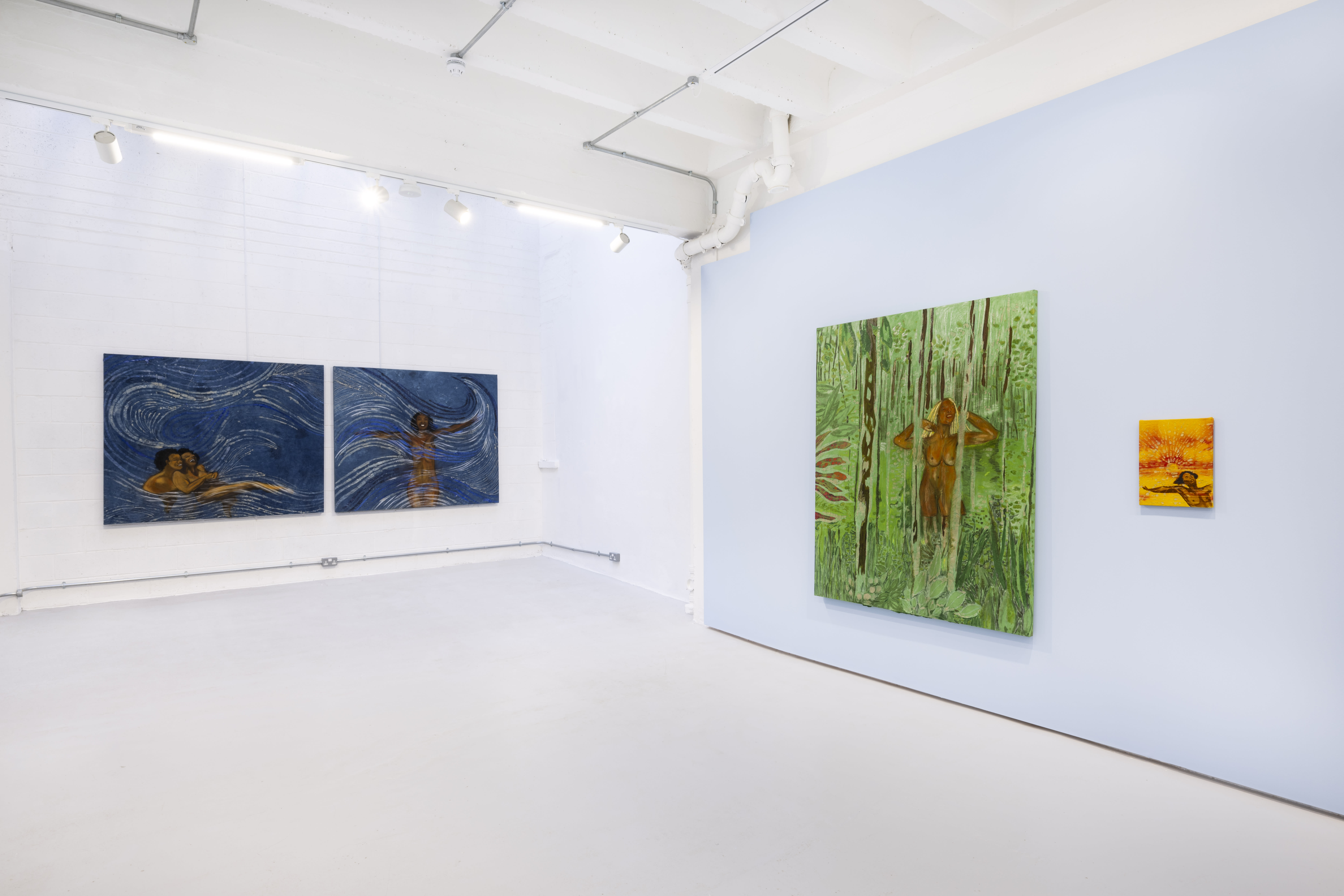To coincide with Islands of the Blessed, Berntson Bhattacharjee spoke with Sola Olulode to discuss her creative processes, research and muses.
BBG: How was this body of work born?
SO: I started thinking about this body of work during my trip to Barbados back in 2021. It was my first real break from work since graduating in 2018 and also my first time visiting the Caribbean. I spent seven weeks there, and it was pure relaxation and leisure. Island life really appealed to me—swimming in the sea every day, visiting botanical gardens, watching the brilliant colours lighting up the sky during the sunsets. I knew I wanted to make a body of work influenced by these settings and colour palettes. Since then, I’ve visited different Caribbean islands a few more times and travelled quite a bit elsewhere, being influenced by this kind of landscape again and again. The idea to set a series of work on an island was initially a way of expanding my colour palette. I’ve tended to be quite monochromatic over the years, and in the Caribbean, there are so many different colours melting into each other and contrasting with each other, and I wanted to show more confidence with colour in my work. I then started thinking more about this space I was creating. Where was it? How do these figures fit into the themes I was already exploring? My interest geared towards creating a beautiful space where people could experience pure leisure and freedom. This idea of paradise kept coming up.

Installation View of Islands of the Blessed
BBG: You’ve been delving into an exploration of the historical significance of parks and gardens as meeting points for the LGBTQI+ communities, pictorially referencing your trips to Barbados, Lagos, Taipei, and other regions that have had a lasting impact on you. Are there any specific parks and gardens from your travels and in London that have stood out for you as having an interesting queer history?
SO: I love going for walks in parks, hikes, and visiting botanical and conservation gardens. There are a few particular places from trips and holidays over the past few years that feature in the paintings. I combined images I took from Lekki Conservation Gardens in Lagos, lakes I swam in Berlin, some of the botanical gardens in Barbados in the painting A Moment To Myself, and a few scenes from hikes in Antigua in A Place We Can Be Free,—a real fusion of all the places I’ve visited where I found peace in the past few years. I became interested in outside spaces as meeting points for many queer people historically.
I spent a lot of time in Taipei at the beginning of last year and, on one of the days, visited the memorial park 228 on the day of the memorial. A friend of mine remarked, “best tourist ever,” as they said locals didn’t really care much for the park. It’s better known for being a place where closeted gay men went to have sex in the 80s and 90s. Previous works of mine have explored the park as a date location, but it also has this association in LGBTQIA+ history as a place for cruising or a place where queer people could be hidden when they weren’t free to explore their relationships in the comfort of their own homes.
It reminded me of when I was in a botanical garden in Barbados. There was a point at which my friend and I had noticed a queer couple sitting on a bench together, clearly sharing an intimate moment, and when we came to their view, they quickly moved on. It was a really beautiful moment for me. We got really excited because we hadn’t witnessed a lot of visibly queer people in public, as at the time, I think it wasn’t legally acceptable to be queer. Since then, the law has changed, thankfully. One of my favourite pastimes was to watch the couples sit and gaze upon the sunset together on the beach every evening. This felt really special to get a glimpse of potentially a more secretive relationship in that location.
BBG: How do you navigate the intersection between historical significance and contemporary perspectives in your artistic process of integrating queer and gender-fluid mythological figures into spaces with cultural importance for the LGBTQ+ community?
SO: In my previous series of work, I’ve explored nightlife as a space where people can come together, and I often contemplate the importance of placing queer people in outdoor spaces, allowing them to exist in the daytime, in public, and in sober settings. In reality, many queer people aren’t free to express themselves fully where they live or explore their relationships openly. So, in my paintings, I thought about creating this kind of paradise where people could just be free to exist without fear—a kind of utopia.
Many individuals who had retired to Barbados described the land as paradise, and I often like to think that my figures inhabit a separate world. I want them to experience the purity of freedom, and I feel like that place only exists very briefly in reality or not wholly anywhere on this earth, so they’re in a different realm, a paradise or a haven.

Works L - R, Sola Olulode: Tequila Sunset (2023); Gardens (2023)
BBG: Can you tell me about the starting point of looking into mythology and spirituality? At what point did the work venture from looking at tropical spaces to exploring ancient story-telling?
SO: At some point, I was interested in delving into ancient mythology. I had recently been to Rome and was fascinated by the ancient Romans’ fixation on tragic tales of love, lust, and tragedy. Mostly, I liked the way the figures were painted or carved in sculptures. I also picked up a set of “Greek Lovers” playing cards on holiday that depict various fantastical scenes of lovemaking and orgies. I thought it might be fun to base some of the figures on these images from the cards.I began to read a little bit more into tales of queer mythological stories that are less known. I didn’t find any singular stories that were especially interesting, but the main things that stood out to me were the dramatic and chaotic nature of the tales. The Greek gods are very chaotic beings, but what I did find interesting was the nudity of the figures and the fluidity of genders and sexuality in some of the gods. I decided that I wanted all of my figures to be shown nude in their version of paradise. This was a nice return for me because I’ve always loved painting naked bodies, like most of art history.
During the creation of these paintings, a friend shared some tea from Hong Kong with me, presented in an elaborately decorated tin. They pointed out an image of Guanyin, a gender-neutral Buddhist deity, which reminded me that I had already encountered Guanyin while in Taiwan earlier in the year, initially as a sculpture in a park in Taipei. A friend had taught me about her and how to pray to her statue. I came across many depictions in statues and tributes to her all around Taipei. She talked about the idea of being boundless and transcending this plane and that appeals to me because I often don’t like to project too much on my figures and let them be free to interpret. This reintroduction sparked my interest in queering mythology, and I took it as a good sign to explore themes of gender fluidity more in my figures.
BBG: What led you to exploring constellations? How did these discoveries influence the overall narrative and visual elements of your body of work?
SO: In many of the stories I read about in Greek mythology, the narrative typically involves someone falling in love, a terrible event occurring, a person being cursed in vengeance, and then a god intervenes and saves them. I particularly like the ones where a person is saved by being turned into a constellation. They end up being free, living amongst the stars, sometimes alongside their loved one, forever together. This is quite beautiful and interesting to me because I was looking at patterns of stars as one of the adire tie-dyeing patterns that I had learned from when in Lagos, which references the stars and the moon. My painting, “A Constellation of Lovers,” portrays two figures living amongst the stars with the star-dyed background in reference to these stories. It also feels like a very queer culture reference, reflecting the community’s obsession with the Zodiac and reading the stars to talk about our personalities and the way we relate to one another.

Works L - R, Sola Olulode: A Constellation of Lovers (2023); We Could Just Be (2023)
BBG: Can you tell me about some of the historical and contemporary artworks and artists that you’ve been looking to for inspiration?
SO: I always feel like my paintings are in conversation with some of my early European painter interests, like the pre-Raphaelite works. I think those works first influenced my interest in oil painting and “the female form” as a subject matter. While I now view those paintings as an unhealthy obsession on the artist’s side, exploiting the naked woman’s body, I try to refrain from that history within my works by painting from my perspective of how it feels to exist in a Black woman’s body.
A painting that kept coming up for me when creating scenes of people swimming was John Everett Millais’s Ophelia. Instead of drowning, like in his work, my figures are floating in ecstasy. I’m always looking at Chris Ofili’s works; I’ve been particularly inspired by his most recent paintings I saw in person at “Black Fantastic” at Hayward Gallery. The paintings created a new version of Homer’s Odyssey featuring a Black Odysseus, and his show “The Seven Deadly Sins” at Victoria Miro last year. There’s something mystical and fantastical about the way he paints that I often reflect on when making my works. My partner also gifted me a book on Betty Saar’s work, which I’ve been flicking through a lot while creating these works. Her work “Celestial Universe” (1988) also references zodiac signs and figures of the constellations originating from Greco-Roman mythology, inspiring me to create that link in this series.
BBG: Do the figures in the works represent specific deities and gods, or are they fictional, or perhaps people from your own life?
SO: The figures actually don’t represent any particular gods. I didn’t feel in tune enough with the ones I read about to want to physically represent them. The figures, to me, more represent the idea of goddesses, choosing instead to display the energy of what it feels like to be a god—lounging around in heaven, falling in love with someone (or yourself). As it happens, many of the images are from my holiday snaps, so some of the figures in the paintings do reference friends, and surprisingly, there’s a lot of myself in there. I had a lot of photos that had been taken of me on nude beaches that worked perfectly for the scenes I was creating. Those moments I had while on holiday, finding secluded beaches to swim naked in Antigua or engaging in nudist outside swimming in Greece and Berlin, have felt like such blessings. To be at one with nature and truly uninhibited. That was exactly the energy I wanted to bring into the work.

Installation View of Islands of the Blessed
BBG: You attended a workshop in Lagos with traditional dyers who taught you dye techniques and the meanings behind various different tie-dyes. Can you please tell me about that experience of learning from traditional dyers?
SO: Yes, I had been visiting Lagos to do a duo show with Wunika Mukan Gallery, and in partnership with the Yaowa foundation, they had organised for me and the other artist in the show, Paul Majek, to do a workshop because we were both interested in the adire cloth-making process of the Yorubas in different ways. So, we had a traditional Adire workshop hosted by Nike Art Gallery where we learned the ancient art of Adire Elekon from expert weavers from Kogi State. The traditional dyers taught us about the history of adire, the different techniques they used to create the patterns, and the meanings behind the symbols used in their patterns. I loved hearing names of the patterns and the reasons one might wear that particular cloth to tell a story about themselves or spread a message. There was a pattern that referenced the moon and the stars that stuck with me, and I’ve used the techniques they taught us in this series. Even though I’ve been dyeing my canvas for years, I’ve mainly been using batik and not exploring more traditional ways of resistance dyeing, so it was nice to bring that in for a couple of the works, and I want to explore that further in new works to come.
BBG: Your material pursuits of taking traditional techniques, such as batik, and marrying them with your contemporary visual language is very interesting. How are you developing these traditional techniques and processes?
SO: My starting process usually depends on whether I have an image in mind already or whether I’m just experimenting with a particular technique for a background. In these new works, for some, I just had an idea for the pattern canvas, a scene set under the stars or in a tropical garden. Sometimes, I start with the outline of the figure; it’s all about what parts I want to show with resist or wax. I sometimes add pigment into my wax while I’m applying it to create a different depth for the batik. Then comes the dyeing. The majority of the works are still in my signature Indigo dye, but as I wanted to expand my colour palette for this series, I did introduce more colours, mainly greens, and because of the sunset scenes, I wanted to capture all of those different hues and colours lighting up the sky using purples, red, and a dash of yellow, as I have done in the past. Once I have dyed the canvas and stretched it, sometimes I remove the wax so I can get the real resistance, and other times I leave it on for texture. Then, I begin to think about where the figures might go. I look through my reference images, and sometimes just get ideas out of my head. Then the real mix of media starts depending on the scene. I mainly work with oil paint, fusing the transition of oil painting with the textile design by mapping out areas for paint with primer. Sometimes, that isn’t enough, and I work into the canvas with oil pastels, pastels, inks, charcoal, more wax laid over the top, and a lot of pigment just rubs onto the surface of the canvas, building up with each material until I have created the scene I desire.

